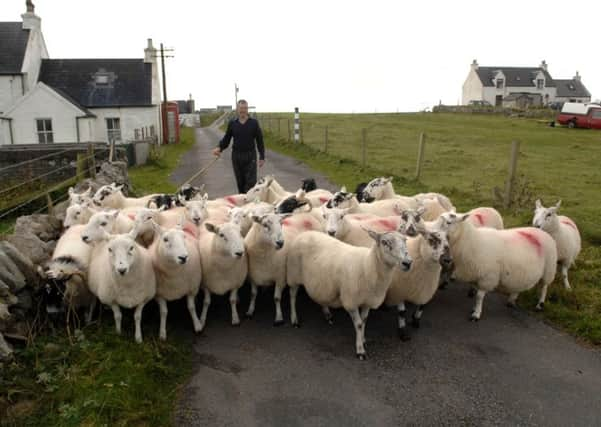UK pledge over £42m Scottish hill farm cash '˜not enough'
This article contains affiliate links. We may earn a small commission on items purchased through this article, but that does not affect our editorial judgement.


The announcement was made yesterday during his visit to a farm at Ballindalloch, Moray, where he confirmed the UK government would guarantee 2019 applications under the less favoured areas support scheme (LFASS).
• READ MORE: Farming news
“Crofters and farmers are the lifeblood of the Highland economy,” he said. “Battling challenging conditions they produce world-class food while serving as custodians of the natural environment. Put simply, they shape Scotland, and merit support and certainty as we leave the EU.
Advertisement
Hide AdAdvertisement
Hide Ad“It is for that reason that the UK government is guaranteeing an additional £42m to extend the less favoured areas scheme for an extra year. This will mean payments of up to £10,000 each for Scotland’s eligible hill farmers, giving farmers greater certainty while we develop a strategy to support our agriculture sector once we leave the EU.”
Lord Duncan added the government would also guarantee other CAP Pillar 2 or non-direct projects signed before the UK leaves the EU in March 2019.
• READ MORE: ‘Cut’ in rural development cash sparks fresh attacks
However, Scottish rural economy secretary Fergus Ewing was less enthusiastic, saying the announcement needed to go further. “We still have no certainty over the future of Pillar 2 funding. Indeed, this announcement would appear to contradict recent commitments by the UK government to maintain total farm support budgets until 2022.
“This piecemeal approach is not the way to go about creating clarity and certainty over future rural support. It is just a shame that they could not have provided this clarity and certainty a year ago when I first asked for it.”
NFU Scotland president Andrew McCornick, who attended the farm visit where the announcement was made, said that since the outcome of the EU referendum, the union had continually challenged UK and Scottish governments to provide continuity and stability.
“LFA payments are a support anchor for thousands of Scotland’s most fragile farming and crofting businesses. This lifeline rural development payment is often worth more to hill farming and crofting businesses than the direct support received through Pillar 1.
Advertisement
Hide AdAdvertisement
Hide Ad“Hill farming is a long-term commitment and breeding and management decisions being made this autumn will have an impact many years into the future.”
He added: “The UK government has already committed to funding levels for direct support payments until 2022, the end of the current parliament.
“It is imperative that it now makes a similar commitment on rural development funding. That would make a genuine difference to the confidence of those farming and crofting in LFA areas and allow them to plan ahead with a greater degree of certainty.”
McCornick confirmed the Union would now press the Scottish Government on its funding commitment to LFASS in 2019 while also continuing pressure on both governments over further funding levels that recognises all of Scotland’s rural development measures.
Outlook is brighter for farm profits
A leading farm economist has suggested the outlook for UK farm profitability in 2018 is brighter than it has been for some years.
Writing in the latest edition of the John Nix Farm Management Pocketbook, Graham Redman put projected returns for most farming sectors at their highest levels for four years.
He suggests the gross margin for feed wheat next year for an average producer could reach £744 per hectare or £300 per acre, up about 12 per cent, based on a price on a futures price of £140 per tonne which is roughly where November 2018 ex-farm prices currently sit.
He is similarly upbeat about winter oilseed rape with projected outputs of £662 per hectare, the highest margin for the crop since 2014.
Advertisement
Hide AdAdvertisement
Hide AdIn the livestock sector, he believes the outlook is equally positive, with dairy budgets up above the 2016 and 2017 years with all-year-round calving herds averaging a gross margin of over £1,000 per cow, a level not seen since 2015.
• READ MORE: Farm incomes slashed by almost 50% in one year
For beef, autumn lowland suckler herds are predicted to generate £200 per cow head, again a figure not achieved for many years, while sheep gross margins return a strong set of results from lowland and upland lambing as well as rearing and finishing.
The figures in the book are for the “average farmer” but he warns that the biggest difference between top and bottom farmers is often the overheads and these are more difficult to measure.
“It is easy for rising overheads to erode any additional gain from gross margins and the need to keep tight control of them is as important as ever,” he said.